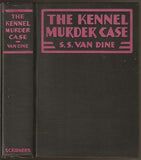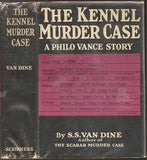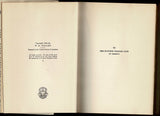The Kennel Murder Case: A Philo Vance Story
Author: S. S. Van Dine [PSEUD Willard Huntington Wright (1888-1939)] signed with letter
Year: 1933
Publisher: Charles Scribner's Sons
Place: New York
Description:
307+[1 blank]+[6 ad] pages with diagrams. Small octavo (7 3/4" x 5 1/2") bound in publisher's original black cloth with chartreuse lettering to spine and cover in original jacket. An association letter laid in from the author signed. First edition with the first printing "A" on copyright page.
Typed letter to Mrs Carolyn Wells Houghton signed with original envelope. Carolyn Wells (1862-1942) was an American writer and poet. Wells was married to Hadwin Houghton, the heir of the Houghton-Mifflin publishing empire founded by Bernard Houghton. She heard That Affair Next Door (1897), one of Anna Katharine Green's mystery novels, being read aloud and was immediately captivated by the unraveling of the puzzle. From that point onward she devoted herself to the mystery genre. Among the most famous of her mystery novels were the Fleming Stone Detective Stories which—according to Allen J. Hubin's Crime Fiction IV: A Comprehensive Bibliography, 1749–2000 (2003)—number 61 titles.
Wright wrote as a critic and journalist until 1923, when he became ill from what was given out as overwork, but was in reality a secret drug addiction, according to John Loughery's biography Alias S.S. Van Dine. His doctor confined him to bed (supposedly because of a heart ailment, but actually because of a cocaine addiction) for more than two years. In frustration and boredom, he began collecting and studying thousands of volumes of crime and detection. In 1926 this paid off with the publication of his first S. S. Van Dine novel, The Benson Murder Case. Wright took his pseudonym from the abbreviation of "steamship" and from Van Dine, which he claimed was an old family name. Wright wrote a series of short stories for Warner Brothers film studio in the early 1930's. These stories were used as the basis for a series of 12 short films, each around 20 minutes long, that were released in 1930 - 1931. Of these, "The Skull Murder Mystery" (1931) shows Wright's vigorous plot construction. It is also notable for its non-racist treatment of Chinese characters, something quite unusual in its day. As far as it is known, none of Van Dine's screen treatments have been published in book form and none of the manuscripts survive. Short films were popular then and Hollywood made hundreds of them during the studio era. Except for a handful of comedy silents, however, most of these films are forgotten and not listed in film reference books. Wright died April 11, 1939, in New York City, a year after the publication of an unpopular experimental novel that incorporated one of the biggest stars in radio comedy, The Gracie Allen Murder Case, and leaving a complete novelette-length story that was intended as a film vehicle for Sonja Henie, and was published posthumously as The Winter Murder Case.
The Kennel Murder Case is a 1933 murder mystery novel, written by S. S. Van Dine, with fictional detective Philo Vance investigating a complex locked room mystery. One of the Coe brothers is found dead in his bedroom, locked from the inside, and the other brother is found the next morning dead in the downstairs closet. There is also the clue of a wounded Doberman Pinscher, a mysteriously broken piece of priceless Chinese porcelain, and a cast of suspicious family members, servants and associates. Philo Vance solves the case based on his knowledge of dog breeding, Chinese porcelain and the annals of remarkable antique crimes. A Warner Bros. film version of The Kennel Murder Case appeared in 1933. The film was directed by Michael Curtiz and starred William Powell as Philo Vance, reprising the role after appearing as Vance in three earlier films for Paramount, and Mary Astor as Hilda Lake, the victims' niece. Many film historians (including William K. Everson, who pronounced it a "masterpiece" in the August 1984 issue of Films in Review) consider it one of the greatest screen adaptations of a Golden Age mystery novel, and rank it with the 1946 film Green for Danger. It was remade by Warners in 1940 as Calling Philo Vance with James Stephenson as Vance and William Clemens directing. World War II-era espionage stood in for the skulduggery of the art world in the remake.
Condition:
An small old bookseller's tag at the back head inner hinge, slightly cocked. Jacket corners and spine ends chipped with some closed tears and creases else a very good copy in like jacket.
Year: 1933
Publisher: Charles Scribner's Sons
Place: New York
Description:
307+[1 blank]+[6 ad] pages with diagrams. Small octavo (7 3/4" x 5 1/2") bound in publisher's original black cloth with chartreuse lettering to spine and cover in original jacket. An association letter laid in from the author signed. First edition with the first printing "A" on copyright page.
Typed letter to Mrs Carolyn Wells Houghton signed with original envelope. Carolyn Wells (1862-1942) was an American writer and poet. Wells was married to Hadwin Houghton, the heir of the Houghton-Mifflin publishing empire founded by Bernard Houghton. She heard That Affair Next Door (1897), one of Anna Katharine Green's mystery novels, being read aloud and was immediately captivated by the unraveling of the puzzle. From that point onward she devoted herself to the mystery genre. Among the most famous of her mystery novels were the Fleming Stone Detective Stories which—according to Allen J. Hubin's Crime Fiction IV: A Comprehensive Bibliography, 1749–2000 (2003)—number 61 titles.
Wright wrote as a critic and journalist until 1923, when he became ill from what was given out as overwork, but was in reality a secret drug addiction, according to John Loughery's biography Alias S.S. Van Dine. His doctor confined him to bed (supposedly because of a heart ailment, but actually because of a cocaine addiction) for more than two years. In frustration and boredom, he began collecting and studying thousands of volumes of crime and detection. In 1926 this paid off with the publication of his first S. S. Van Dine novel, The Benson Murder Case. Wright took his pseudonym from the abbreviation of "steamship" and from Van Dine, which he claimed was an old family name. Wright wrote a series of short stories for Warner Brothers film studio in the early 1930's. These stories were used as the basis for a series of 12 short films, each around 20 minutes long, that were released in 1930 - 1931. Of these, "The Skull Murder Mystery" (1931) shows Wright's vigorous plot construction. It is also notable for its non-racist treatment of Chinese characters, something quite unusual in its day. As far as it is known, none of Van Dine's screen treatments have been published in book form and none of the manuscripts survive. Short films were popular then and Hollywood made hundreds of them during the studio era. Except for a handful of comedy silents, however, most of these films are forgotten and not listed in film reference books. Wright died April 11, 1939, in New York City, a year after the publication of an unpopular experimental novel that incorporated one of the biggest stars in radio comedy, The Gracie Allen Murder Case, and leaving a complete novelette-length story that was intended as a film vehicle for Sonja Henie, and was published posthumously as The Winter Murder Case.
The Kennel Murder Case is a 1933 murder mystery novel, written by S. S. Van Dine, with fictional detective Philo Vance investigating a complex locked room mystery. One of the Coe brothers is found dead in his bedroom, locked from the inside, and the other brother is found the next morning dead in the downstairs closet. There is also the clue of a wounded Doberman Pinscher, a mysteriously broken piece of priceless Chinese porcelain, and a cast of suspicious family members, servants and associates. Philo Vance solves the case based on his knowledge of dog breeding, Chinese porcelain and the annals of remarkable antique crimes. A Warner Bros. film version of The Kennel Murder Case appeared in 1933. The film was directed by Michael Curtiz and starred William Powell as Philo Vance, reprising the role after appearing as Vance in three earlier films for Paramount, and Mary Astor as Hilda Lake, the victims' niece. Many film historians (including William K. Everson, who pronounced it a "masterpiece" in the August 1984 issue of Films in Review) consider it one of the greatest screen adaptations of a Golden Age mystery novel, and rank it with the 1946 film Green for Danger. It was remade by Warners in 1940 as Calling Philo Vance with James Stephenson as Vance and William Clemens directing. World War II-era espionage stood in for the skulduggery of the art world in the remake.
Condition:
An small old bookseller's tag at the back head inner hinge, slightly cocked. Jacket corners and spine ends chipped with some closed tears and creases else a very good copy in like jacket.



















